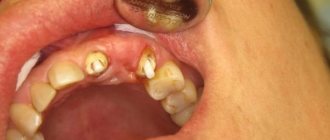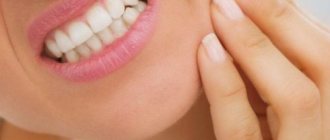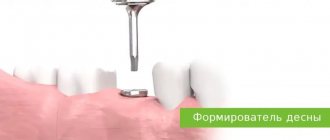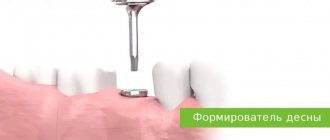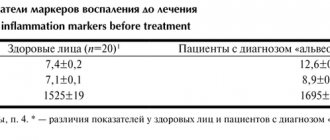Many of us have encountered such an unpleasant sensation as toothache, which appears for various reasons, but the most common of them is the patient’s improper care of his oral cavity. As a result, severe damage to the teeth occurs. If there are serious pathologies, a pin is placed on the tooth. The reason for this is the beginning of the destruction of the crown. Because of this, additional support is required to help with subsequent recovery.
What should someone do if a tooth with a pin without a nerve hurts? Let's find out in the article.
About the dental post
A dental pin is a structure made from a special impression. It is installed in a previously prepared root canal of the tooth. The pin is used as a support for dentures.
It is worthwhile to dwell in more detail on the classification of rods that strengthen damaged teeth. Since there are a large number of pins and each of them has its own characteristics, it will be extremely important to understand and not get confused in all the diversity.
Remember ! Only the attending dentist decides which pin would be appropriate to use in each possible case.
First of all, there is a classification of pins according to the material from which they are made.
- Metal pins (also called anchor pins) are installed more often than others. Typically made from surgical steel, titanium, as well as platinum, gold and other various alloys.
- Carbon fiber is used as the material for the pins. Such rods are called elastic. Their characteristics are close to the natural dentin layer.
- Fiberglass posts are also very flexible and also have translucent properties - a big plus when placing them on the front teeth.
- Pins made of metal alloys with a polymer coating are called parapulpal. Usually they are installed not at the root of the tooth, but as a supporting structure.
- Another material for rods is gutta-percha. It is good for its environmental friendliness. Pins made from this material are much cheaper than others, but their service life is still shorter.
- Individual stump inlays. They are usually placed when the crown is completely destroyed.
There is also a classification based on the method of attachment to the tooth. According to it, the pins can be divided into:
- active pins - secured to threads for strength and durability;
- passive - installed in the tooth canal using a fixing solution. They do not last as long and are used for serious damage and expansion of the tooth canals.
According to the fastening method, pins can be divided into screw, cylindrical and conical.
In what cases is a pin placed?
Dentists prescribe pin implantation when the crown is destroyed by more than 50%. In this way, the thinned walls are strengthened. The pin is also installed when building up stumps for artificial crowns.
In what situations is it not recommended to install a pin:
- the periodontium does not hold the tooth well;
- small root size;
- root caries damage
- the channel is perforated;
- cysts were diagnosed at the roots;
- for blood diseases;
- The walls of the tooth root are very thin.
Advantages and disadvantages
Positive aspects of the installation:
- a decaying tooth retains its shape;
- in the future, you can build up the tooth stump to install ceramic crowns;
- it becomes possible to restore the enamel;
- This way you can prevent tooth extraction;
- The pins are durable and should be replaced no earlier than every ten years.
The disadvantages of this design include the following:
- the pin can become one of the causes of tooth decay;
- if the rod is installed incorrectly, it can cause caries;
- metal pins are susceptible to corrosion from external factors;
- allergies and pin rejection may occur;
- over time, the walls of the tooth become thinner, which leads to the subsequent removal of damaged teeth;
- installing a pin is a fairly expensive procedure, especially when using modern materials.
A tooth hurts under a crown: what to do?
As already mentioned, self-medication is strictly prohibited. But even a doctor can’t easily cope with a patient’s problem. It is necessary to re-treat the canals, but there are a number of possible difficulties:
- If a pin has been installed in the root, removing it will be very problematic. There are often cases when an attempt to get rid of the pin leads to a root fracture and subsequent tooth extraction.
- For high-quality filling of the canals, they should be unsealed. During unsealing, perforations may appear.
- Anti-inflammatory treatment after the filling procedure is mandatory. It lasts at least a couple of months, during which you will also have to visit the doctor several times to monitor the situation.
- After completing the course of anti-inflammatory therapy, it is time to re-fill the canals (naturally, it must be done in compliance with all requirements, i.e. to the end of the roots) and install a crown.
- Sometimes root resection is prescribed: a hole is drilled in the bone, through which the upper section of the root and the pus-filled sac are removed. Despite the apparent complexity, the operation does not last long. In addition, you will not have to remove the crown, which will significantly save money and time.
Why does pain occur after installation?
The causes of pain with a pin installed cannot be identified on your own. If you notice that after implantation the tooth area begins to hurt, be sure to make an appointment with a doctor.
Pain occurs due to unprofessional or erroneous actions of the dentist.
- The pin is set too deep. The pain is felt during physical impact (for example, chewing) and has an aching character.
- During installation, the dental canal was cleaned with errors, and the walls of the tooth were damaged.
- The filling material has not completely filled the root canal. It could also simply extend beyond the apical foramen.
- When a fragment or several fragments are found in the canal belonging to endodontic instruments.
- In case of poorly performed disinfection of the canal during the procedure.
Important ! When installing the pin, the doctor requires high concentration.
During cleaning, it is necessary to use all the necessary instruments and identify the position of the apical foramen. To monitor the condition, an additional x-ray is prescribed.
In addition to incorrectly performed medical procedures, there may be other causes of painful sensations.
Normally, aching pain in a tooth can last up to several days; over time it subsides and disappears completely. Sometimes the pain is associated with an allergy, when the body does not accept the material from which the pin is made. In such cases, x-rays usually show the real picture.
If pain is not observed immediately after the intervention, but after a long period, for example, after several years, then the reasons that led to its occurrence may be as follows.
- Failure to maintain proper oral hygiene.
- Minor damage to tooth tissue (usually occurs due to biting nuts and other hard objects, opening lids with teeth, etc.).
- Periodontal inflammation.
- The appearance of cysts on the roots of teeth.
- Serious tissue damage.
Video - Dentist about pain in a tooth without a nerve
Symptoms of complications
If a tooth with a pin hurts when pressed, most often this means that the rod is installed quite deeply. It rests on the jaw bone and causes discomfort. With the development of serious complications, patients complain of:
- the appearance of edema;
- severe itching;
- tissue redness;
- increased body temperature;
- headaches with the development of osteomyelitis;
- feeling of fullness with granulum;
- severe pain when the root splits;
When a tooth without a nerve with a pin hurts, soft tissue may be affected. They become inflamed, swollen, and red. Patients experience itchy, aching pain that bothers them for a long time, even though the nerve has been removed and the masticatory organ has lost connection with the central nervous system. If discomfort appears immediately after surgery, this is a natural process. After a few days the pain will subside and then go away completely. If discomfort increases, you should consult a dentist.
Symptoms
Complications are expressed by the following symptoms.
- Pain due to external impact on the tooth (pressure or chewing) or eating too hot or cold food (has aching character).
- Swelling of the gums.
- Fever, nausea and weakness.
Important ! The latter symptoms may indicate the cause of complications after the installation of the pin - allergies.
Installing a pin is a good way to preserve tooth health for at least five to six years. Unfortunately, conventional fillings cannot completely solve the problem of serious damage to dental tissue. The pin installation procedure is painless, and using the latest generation materials can significantly reduce the likelihood of complications.
However, sometimes complications still arise. What could they be?
It was mentioned above that pain often occurs after implantation of the rod. Its reasons are different.
It happens that the dentist did not approach the process of installing the rod professionally enough. The reasons are:
- too deep implantation when the pin comes into contact with the bone;
- the walls of the teeth are damaged, the root canals are perforated;
- small amount of filling material;
- debris of dental instruments entering the tooth canal;
- acute pain may appear due to purulent formation, which leads to swelling of nearby tissues;
- if severe inflammation begins, this is fraught with the occurrence of fistulas due to the effect of purulent discharge on the mucous membranes and gums;
- if the patient has chronic periodontitis, there is a risk of cysts.
Another common cause of pain after a pin is inserted is an allergy to the material from which the pin was made. Signs that the body does not perceive the structure well may include weakness combined with elevated body temperature, as well as inflammation in the oral cavity. Complications also arise when there is insufficient attention to hygiene procedures, for example, brushing the teeth and oral cavity.
Why does a tooth hurt under a crown? There are several reasons for this phenomenon
Before prosthetics, the tooth was unsatisfactorily prepared for this procedure
Firstly, dentists often make an unfortunate mistake by filling the dental canals not to the very top of the root, which results in problems for the patient in the future. When starting prosthetics, the pulp is first removed from the tooth, then the canals are filled. This procedure must be carried out in compliance with clearly defined standards that reduce the risk of inflammation near the roots in the future to a minimum.
Sometimes a doctor, due to inexperience, carelessness or lack of qualifications, does not fill the canal completely, but only 2/3 of its full length, creating excellent conditions for the development of pathogens.
The unsealed section of the canal is clearly visible on an x-ray, but the formed abscess can be seen in the image in the area with active darkening. A doctor’s oversight can be the beginning of the development of periodontitis, a disease characterized by the transition of the inflammatory process from the pulp to the upper part of the root.
Secondly , the cause of pain may be insufficient filling or, scientifically speaking, obstruction of the canal with the material used for the filling procedure (styler or gutta-percha). That is, at first glance, the doctor fills the filling correctly, i.e. reaching the end of the canal, however, the material is not packed tightly enough, there are voids, and periodontitis develops.
Small holes in the walls of the canal
Perforation is not a natural hole, but, to put it very simply, an ordinary hole formed artificially. There is only one natural opening in a tooth, located near the top of the root.
Perforation appears:
- when processing dental canals due to mistakes made by the doctor performing the procedure (the instrument used goes perpendicular to the canal, as a result of which holes appear on the root wall);
- when fixing the pin, when the doctor violates the technique of this operation.
Tool breakage in the channel
The main reasons for instrument failure, resulting in toothache under the crown:
- Incorrect rotation of the device. The devices used in root canal treatment are very thin and can easily be broken if the operating instructions are not followed. Many instruments are not designed to rotate 120 degrees or more: when the device is fully rotated, as you might guess, it can easily be broken, since the channels are not straight, but curved.
- Multiple uses of one tool to expand channels. Dental instruments are made from metal that has special properties. The use of any metal over time leads to the appearance of cracks in it that are invisible to the eye: this phenomenon is called metal fatigue. The more times a tool is used, the higher the risk of breaking it during operation. Devices for processing canals can be of different thicknesses - this parameter is indicated by a number (the thinnest tools are produced under numbers 6, 10, 15). In foreign dentistry, it is generally prohibited to use them twice, which every dentist is aware of. However, in Russia it has long been the case that tools are used as long as they can be used, and there are no positive trends towards changing this situation: it is not surprising that the frequency of failure in the channel of these devices is quite high.
- When performing manipulations in curved channels. There are difficult-to-pass channels, when working with which the instrument breaks off not through the doctor’s fault, but for a natural reason. Working in a curved canal is a very risky undertaking, but often it is simply unavoidable. Removing a small broken piece from the canal is very difficult, if not impossible. A foreign body creates obstacles for high-quality filling and, as a result, inflammation begins and pain occurs.
How does the installation take place?
When preparing for the procedure, many patients wonder how exactly the intervention will take place. The complex of restorative actions is divided into two conventional stages - directly working with the pin and the process of restoring the tooth through prosthetics.
Important ! How the pin will be installed depends primarily on its type and material.
However, the procedure is usually unchanged. It must always be observed, no matter what teeth the pins are installed on: incisors, canines, molars or premolars.
Accordingly, actions are performed in this order.
First of all, the patient is examined by a dentist. If concomitant conditions are discovered that may adversely affect the result, they must be pre-treated. Thus, you first need to cure caries and other pathologies of the oral cavity and teeth. In order to avoid complications caused by bacterial damage, professional sanitation of the oral cavity is performed.
An X-ray of the decayed tooth is also taken. Based on the information from the image, the dentist determines the characteristics of the tooth: length, angle of inclination and root diameter.
Next, the doctor determines which pin will be installed and how. On the appointed day before installing the rod, it is better not to eat food.
The intervention is carried out after the administration of local anesthesia: it is injected into the gum next to the damaged tooth. As soon as it begins to act, the procedure itself is carried out.
The dental canals are thoroughly cleaned. To do this, drills are used, usually small in size, so as not to accidentally damage the canal and cause the formation of cracks and other damage. If necessary, expand the channel.
Interesting ! A filling is usually placed at the top of the root.
If a passive pin is installed, a cementing mixture is placed into the canal. A pin is placed in it, and it is thoroughly dried using a special dental lamp.
Next, the dentist conducts a control check and schedules the next appointment for further prosthetics.
How to build teeth onto pins, what is this process?
Prosthetics are performed after the pin is installed. Nowadays in dentistry, modern materials are used to make prosthetics; crowns are installed, as well as bridge prostheses if several teeth have been damaged at once.
First, the doctor must shape the filling material into the tooth around the post. It is shaped, filed and polished. What the result will be depends primarily on the experience of the dentist who works with this problem.
If the tooth is seriously damaged, a crown is installed. It is a special prosthesis that cannot be removed and is performed individually for each patient. Usually the cost of crowns is quite high.
The entire prosthesis imitates a damaged tooth. It is fixed on the pin using a special strengthening solution. After the crown is installed, some time must pass. Then the doctor checks whether her body rejects it or not. Implantation is considered successful if the prosthesis is installed tightly and there are no signs of inflammation.
Useful tips for preventing inflammation and bleeding gums
On the upper jaw, new teeth take about five to six months to take root; on the lower jaw, it takes about two to four months. The healing time of the bone and gums depends on the quality of the implant, the health of the patient and the condition of the jaw.
To ensure the process is painless and you don’t have any problems in the future, follow these recommendations:
- Visit your dentist periodically (at least twice a year).
- Try to quit smoking or reduce the number of cigarettes to a minimum.
- Carefully care for the implant, remember that it is less strong than your natural teeth.
- At the first signs of gum inflammation, consult a specialist.
Have a beautiful and healthy smile!
Pain on pressure
Sometimes, with external mechanical influence (chewing, pressure), a feeling of pain may occur. This happens quite often, since the treatment process is quite complex, an artificial crown is installed. After some time, the pain goes away.
Another reason that causes pain when pressure is placed on a tooth is when the filling is placed too high. As a result, the jaw stops closing normally. Most often, pain of this nature occurs when chewing food. For prevention, it is recommended to remain under observation in the hospital for some time to understand whether there are any new unpleasant sensations after the intervention.
Characteristic signs of unsatisfactory preparation for prosthetics
The official statistics on poorly performed fillings are depressing: in more than half of the cases, the canal is not filled well enough. How to understand that the tooth under the crown is inflamed?
- I feel pain . This is the very first sign that an abscess has formed in the area of the upper part of the root. The pus presses on the surrounding tissues, so the person feels pain. If the inflammatory process has become chronic, then there may be no constant pain, but discomfort when biting will still persist.
- Gums become swollen, flux appears. Sometimes, with purulent inflammation, the tooth even becomes mobile.
- A fistula appears. A hole in the gum occurs during acute inflammation, which is accompanied by severe swelling of the gums. The abscess contains pus: its amount can increase significantly with a decrease in immunity (this can be seen by a very swollen cheek, increased temperature). Purulent formations try to find a way out: breaking through the mucous membrane and bone, they form a hole. This is how a fistula appears - a small passage in diameter that connects the source of pus formation with the oral cavity. Through this hole, pus enters the mouth, and from there, along with food, into the stomach. As the pus comes out, the inflammatory process subsides. Sometimes the fistula can completely heal, but then the inflammatory process begins to increase again.
- Cyst – This is the extreme stage of the development of periodontitis. It looks like a cavity in the bone, covered from the inside with a fibrous membrane that contains pus.
Any of the above symptoms is a reason to make an appointment with a dentist, and the sooner this is done, the better. First of all, the doctor will send the patient for an x-ray: from the image it will be possible to determine what is the cause of the pain under the crown. It is useless to hope that the pain will go away on its own or to try to drown it out with pills: the only correct option is a visit to the dentist.
Other causes of pain
One of the common causes of pain is the development of inflammation. This process begins approximately 1-2 days after the pin is installed and may indicate that soft tissue was damaged during the procedure and became infected. In the oral cavity, infection occurs quite quickly, so you should not postpone a visit to the doctor for treatment - this is fraught with complications.
There is also such a thing as congenital tooth sensitivity. Usually the patient is aware of this peculiarity. Pain occurs, for example, due to chewing hard food or when eating food that has a contrasting temperature (very cold or hot).
Interesting ! The pain occurs due to congenital sensitivity of the teeth.
If the pin falls out
There are situations when the pin, together with the crown or filling made for it, falls out of the tooth cavity. In most cases, this situation is a consequence of medical errors at the stage of diagnosis or treatment. Reasons for unfixing may be:
- Incorrect determination of indications for pin installation;
- Poor quality fixation;
- Incorrect ratio of the length of the pin and the crown of the tooth;
- Incorrectly adjusted occlusal contacts.
Unfortunately, it is under no circumstances possible to fix the fallen structure back. In such cases, the tooth requires re-treatment, possibly using other methods of restoring the coronal part.
Restoring a tooth using a pin is an inexpensive and relatively quick option for prosthetics of a damaged tooth crown. It allows you to completely restore the lost function of the tooth, as well as achieve high aesthetic values. Since this is not only medical, but also aesthetic dentistry.
Ways to get rid of pain
Under no circumstances should you delay a visit to the doctor if you experience prolonged or progressive pain after installing the pin. The doctor will conduct a full examination, determine the cause and prescribe appropriate therapy. Usually, fluoridation of tooth enamel or building up a layer of enamel using filling material is prescribed.
If the examination shows that everything is in order with the installation of the pin, and the pain occurs on a tooth that is devoid of a nerve, most likely the cause is congenital sensitivity. The patient can cope with it independently, using a special toothpaste with a high content of calcium and fluoride. It is also recommended to use dental floss to remove food debris that causes discomfort and irritation.
When installing a dental pin, it is recommended to rinse your mouth with soda. For about three days, mechanical influences on the tooth from the outside are prohibited; you cannot touch it while chewing. You can take analgesics and apply cold compresses to relieve pain after the procedure.
Pain depending on location and specificity, what does it mean?
Unpleasant sensations can be of a different nature, as well as their location.
- Pulsation at the implantation site, tingling, itching can be either normal or a sign of an allergic reaction to the material. You should continue to take antihistamines (as agreed with your doctor) and monitor the course of such manifestations;
- The unit located next to the installed artificial root is alarming. This may indicate nerve damage, gum inflammation or unsuccessful implantation, or it is possible that the crown is pressing, so the adjacent tooth hurts after the implant is installed;
- Severe pain in the ear after dental implantation in the lower jaw, which does not go away within a week, may indicate a violation of the integrity of the trigeminal nerve. The cause may be an incorrectly installed implant or injury from an instrument when preparing the bed;
- The answer to the question of why and how much gum pain after implant installation depends on the person’s health. Normally, the gums may ache for 5-7 days
. By the day the sutures are removed, usually on the 7th day, the pain goes away; - Bursting pain near the implant, the appearance of pus with light pressure, and temperature may indicate an inflammatory process. The main thing is to prevent the infection from joining. You should immediately consult a doctor.
Removing a dental post
The pin is removed in the following situations:
- if the apical part of the root becomes inflamed;
- when a filling needs to be replaced;
- during the preparatory stage before implantation;
- with unprofessional and poor-quality installation of the pin.
Removal of the pin is carried out in several stages. First, old fillings, crowns and other structures installed earlier are removed. Then, using ultrasound, the cement holding the pin is destroyed.
After this, you can directly remove the pin using forceps.
Important! If the pin is very firmly fixed in the root canal of the tooth, then ultrasound treatment is performed - due to vibrations, the pin moves, and this makes it easy to remove it.
After the procedure is completed, the doctor must check the patency of the root canals.
The pins are removed painlessly; this procedure does not pose any danger to the patient. Even anesthesia is not used in this case - only vibration and light pressure are felt.
After installing a dental post
As we have already noted, after a rod has been installed or a crown has been built up, pain is normal for some time. Usually this condition goes away after three days.
However, if you notice that the pain lasts longer or does not subside, but only intensifies, you should immediately visit a dentist. This may indicate damage to the roots of the teeth or the pin being installed too deeply when it comes into direct contact with the bone tissue. The cause can only be determined using an x-ray.
Important! Some patients may be allergic to the material from which the pin is made - then we are talking about symptoms such as redness or swelling. This condition should not be neglected under any circumstances; complications such as serious inflammation - stomatitis or periodontitis - may occur.
After the pin is installed, the patient is recommended to follow a certain regimen to help him recover faster after the intervention. These recommendations should be followed for approximately two weeks.
- Give preference to soft foods to avoid stress on your teeth.
- The toothbrush should be replaced with one with the softest bristles.
- The first time after installing the pin, you should not use electric toothbrushes, toothpicks or dental floss in the area of the tooth where the rod is installed.
- Smoking should be avoided for at least one day after the pin is installed.
- Regularly use a mouth rinse solution prescribed by a specialist.
- Physical activity is minimized or eliminated completely.
- You must strictly adhere to the treatment prescribed by your dentist.
To prevent and strengthen the immune system, immunostimulants, for example, Imudon, are often prescribed before and after intervention. This drug has proven itself as a means of strengthening local immunity and protecting against infections and inflammation after the procedure.
"Imudon" is indicated for use by children over three years of age and adults. It has a convenient form of administration - these are lozenges with mint flavor.
Let's sum it up
Pain after insertion of a pin occurs for various reasons, but moderate pain is normal. The maximum time through which they must pass is up to five days. If the pain lingers for a longer period of time, it is necessary to consult a doctor who will find out what caused the pain.
However, if erroneous and unprofessional actions of the dentist were noticed, which include installing the rod too deeply, non-compliance with the rules for filling the root canals, damage to them with dental instruments, an incorrectly fixed pin and pieces of dental instruments accidentally left in the canal, then the pain is usually very intense and you need to get rid of it only after consulting a doctor.



